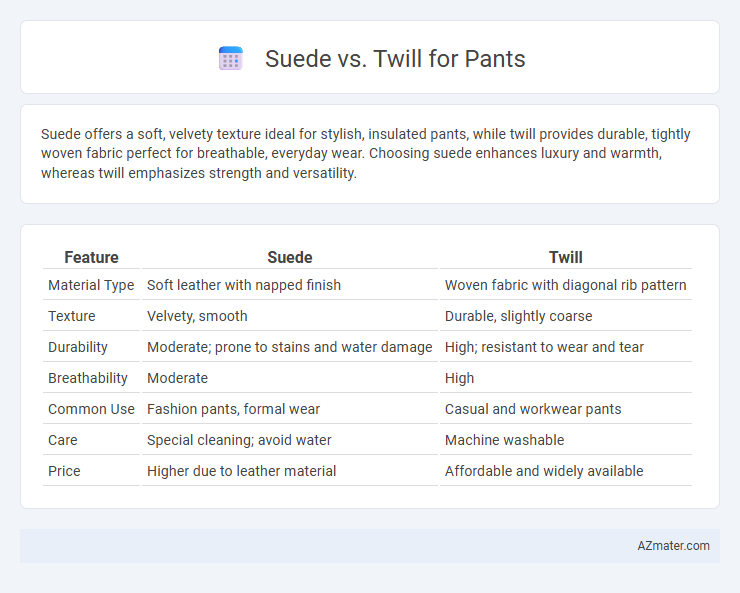Suede offers a soft, velvety texture ideal for stylish, insulated pants, while twill provides durable, tightly woven fabric perfect for breathable, everyday wear. Choosing suede enhances luxury and warmth, whereas twill emphasizes strength and versatility.
Table of Comparison
| Feature | Suede | Twill |
|---|---|---|
| Material Type | Soft leather with napped finish | Woven fabric with diagonal rib pattern |
| Texture | Velvety, smooth | Durable, slightly coarse |
| Durability | Moderate; prone to stains and water damage | High; resistant to wear and tear |
| Breathability | Moderate | High |
| Common Use | Fashion pants, formal wear | Casual and workwear pants |
| Care | Special cleaning; avoid water | Machine washable |
| Price | Higher due to leather material | Affordable and widely available |
Introduction to Suede and Twill
Suede, made from the underside of animal hides, offers a soft, napped finish that provides a luxurious texture ideal for stylish, casual pants. Twill, characterized by its distinctive diagonal weave, delivers durability and resistance to wrinkles, making it a practical choice for everyday wear. These fabric differences influence the look, comfort, and care requirements of pants crafted from suede or twill.
Understanding Suede: Origins and Characteristics
Suede, derived from the French term "gants de Suede," meaning "gloves from Sweden," is a type of leather known for its napped finish and soft texture created by sanding the inner surface of animal hides. This material showcases exceptional breathability and flexibility, making it ideal for comfortable, stylish pants that maintain durability. Its distinctive fuzzy surface differentiates it from twill, highlighting suede's unique elegance and tactile appeal in fashion applications.
What is Twill? Structure and Key Features
Twill is a type of textile weave characterized by a diagonal rib pattern created by the weft thread passing over one or more warp threads and then under two or more warp threads, producing a distinctive diagonal texture. This structure enhances durability and resistance to wrinkles, making twill fabrics ideal for pants that require both strength and comfort, such as chinos or denim. Key features of twill include its sturdy construction, good drape, and ability to hide stains and wear better than plain weaves.
Suede vs Twill: Texture and Appearance
Suede fabric features a soft, napped texture with a matte finish that gives pants a luxurious and velvety appearance, perfect for a refined yet casual look. Twill, characterized by its diagonal weave pattern, offers a smooth surface with a subtle sheen and greater durability, ideal for structured and everyday wear. The tactile difference between suede's plush feel and twill's sturdy, smooth quality significantly influences the aesthetic and functional choice in pant design.
Durability Comparison: Suede vs Twill Pants
Suede pants offer a soft, luxurious texture but tend to be less durable and more prone to wear and staining compared to twill pants. Twill fabric is known for its tightly woven diagonal pattern, providing superior strength, resistance to tearing, and better longevity under frequent use. For durability, twill pants outperform suede, making them more suitable for everyday wear and activities that demand ruggedness.
Comfort and Breathability Factors
Suede pants offer a luxurious, soft texture that provides moderate breathability but can feel warmer due to its dense fiber structure. Twill fabric, characterized by its diagonal weave, delivers excellent breathability and flexible comfort, making it ideal for all-day wear in various climates. Choosing between suede and twill for pants depends on the balance of desired tactile softness versus enhanced airflow and moisture-wicking properties.
Maintenance and Care Requirements
Suede pants require specialized cleaning with a soft brush or suede cleaner to maintain their texture and prevent damage, as water and harsh chemicals can cause staining and stiffness. Twill pants offer easier maintenance, often machine washable and resistant to wrinkles and stains, making them suitable for everyday wear and requiring less frequent professional care. Proper storage for suede involves keeping them away from moisture and direct sunlight, while twill fabric is more durable and can endure regular washing without losing shape or color.
Style Versatility: Outfit Pairing
Suede pants offer a rich, textured appearance that elevates casual and semi-formal outfits, pairing well with leather jackets and crisp button-downs for a sophisticated yet relaxed look. Twill pants boast a smooth finish and durable weave, making them ideal for versatile styling from office wear with blazers to casual streetwear with graphic tees. Both fabrics complement a range of styles, but suede leans toward upscale, seasonal ensembles while twill adapts seamlessly across year-round, everyday outfits.
Price Differences: Budget Considerations
Suede pants typically cost more than twill due to the higher price of genuine leather and specialized manufacturing processes. Twill fabric, usually made from cotton or polyester blends, offers a more affordable option for budget-conscious shoppers. Choosing between suede and twill depends largely on the balance between desired durability, texture, and price sensitivity.
Choosing the Right Fabric for Your Lifestyle
Suede offers a soft, luxurious texture ideal for casual and semi-formal pants, providing warmth and a stylish appearance suited for cooler climates and occasional wear. Twill fabric, known for its durability, breathability, and resistance to wrinkles, is perfect for everyday use, active lifestyles, and warmer weather, ensuring comfort and easy maintenance. Selecting between suede and twill depends on your lifestyle needs: choose suede for fashion-forward, low-maintenance settings, and twill for practicality and long-lasting wear.

Infographic: Suede vs Twill for Pant
 azmater.com
azmater.com